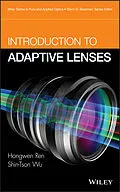Presents readers with the basic science, technology, and
applications for every type of adaptive lens
An adaptive lens is a lens whose shape has been changed to a
different focal length by an external stimulus such as pressure,
electric field, magnetic field, or temperature. Introduction to
Adaptive Lenses is the first book ever to address all of the
fundamental operation principles, device characteristics, and
potential applications of various types of adaptive lenses.
This comprehensive book covers basic material properties, device
structures and performance, image processing and zooming, optical
communications, and biomedical imaging. Readers will find homework
problems and solutions included at the end of each
chapter--and based on the described device structures, they
will have the knowledge to fabricate adaptive lenses for practical
applications or develop new adaptive devices or concepts for
advanced investigation.
Introduction to Adaptive Lenses includes chapters on:
* Optical lenses
* Elastomeric membrane lenses
* Electro-wetting lenses
* Dielectrophoretic lenses
* Mechanical-wetting lenses
* Liquid crystal lenses
This is an important reference for optical engineers, research
scientists, graduate students, and undergraduate seniors.
Autorentext
HONGWEN REN, PHD, is an associate professor in the Department of Polymer-Nano Science Technology at Chonbuk National University in South Korea. A former research scientist??at the University of Central Florida's College of Optics and Photonics, Dr. Ren has published over fifty journal papers, one book chapter, and obtained eight U.S. patents.
SHIN-TSON WU, PHD, is a Pegasus Professor at CREOL, the College of Optics and Photonics, University of Central Florida. He is a recipient of the 2011 SID Slottow-Owaki Prize, 2010 OSA Joseph Fraunhofer Award/Robert M. Burley Prize, 2008 SPIE G. G. Stokes Award, and 2008 SID Jan Rajchman Prize. He is a Fellow of the IEEE, OSA, SID, and SPIE. Dr. Wu has coauthored six books and over 400 journal papers, and holds over seventy issued U.S. patents. He was also the founding editor-in-chief of the IEEE/OSA Journal of Display Technology.
Klappentext
Presents readers with the basic science, technology, and applications for every type of adaptive lens
An adaptive lens is a lens whose shape has been changed to a different focal length by an external stimulus such as pressure, electric field, magnetic field, or temperature. Introduction to Adaptive Lenses is the first book ever to address all of the fundamental operation principles, device characteristics, and potential applications of various types of adaptive lenses.
This comprehensive book covers basic material properties, device structures and performance, image processing and zooming, optical communications, and biomedical imaging. Readers will find homework problems and solutions included at the end of each chapter—and based on the described device structures, they will have the knowledge to fabricate adaptive lenses for practical applications or develop new adaptive devices or concepts for advanced investigation.
Introduction to Adaptive Lenses includes chapters on:
- Optical lenses
- Elastomeric membrane lenses
- Electro-wetting lenses
- Dielectrophoretic lenses
- Mechanical-wetting lenses
- Liquid crystal lenses
This is an important reference for optical engineers, research scientists, graduate students, and undergraduate seniors.
Inhalt
Preface ix
1. Optical Lens 1
1.1. Introduction 1
1.2. Conventional Lens 3
1.2.1. Refraction of Light 3
1.2.2. A Simple Lens 4
1.2.3. A Compound Lens 6
1.3. Aberration and Resolution 7
1.3.1. Paraxial Optics 7
1.3.2. Aberration 9
1.3.3. Resolution 13
1.4. Merits and Demerits of Solid Lens 15
1.5. Adaptive Optical Lenses 16
1.5.1. Eye Structure 16
1.5.2. Lens Character 17
1.5.3. Performances 18
1.5.4. The Eye-Inspired Lens 19
1.6. Homework Problems 21
References 21
2. Elastomeric Membrane Lens 23
2.1. Polydimethylsiloxane (PDMS) Membrane 23
2.1.1. PDMS Chemical Structure 24
2.1.2. Basic Material Properties 24
2.1.3. Optical Transmission 24
2.1.4. Fabrication of PDMS Membrane 25
2.2. Device Structure 27
2.2.1. Requirements of the Liquid 28
2.2.2. Surface Configuration 29
2.2.3. PDMS Lens Cell Fabrication 34
2.2.4. Performance Evaluation Method 36
2.3. Actuators 39
2.3.1. Syringe Pump 39
2.3.2. Motor Pumps 40
2.3.3. Piezoelectric Linear Actuator 50
2.3.4. Artificial Muscles 60
2.3.5. Voice Coil Actuator (VCA) 63
2.3.6. Other Liquid Lenses 64
2.4. PDMS Microlens Array 65
2.4.1. Device Configuration 65
2.4.2. Fabrication Method 66
2.4.3. Performance Evaluation 67
2.5. Solid PDMS Lenses 70
2.5.1. Squeezing the Lens's Border 70
2.5.2. Elongating the Lens's Diameter 72
2.6. Hybrid Lens System 73
2.7. Summary and Technical Challenges 74
2.8. Homework Problems 75
References 76
3. Electrowetting Lens 80
3.1. Introduction 80
3.2. Surface Tension 81
3.3. Contact Angle and Wetting 84
3.4. Basic Theory of Electrowetting 86
3.5. Droplet Deformation 88
3.6. Electrowetting Lens 90
3.6.1. Shape of Droplet Surface 90
3.6.2. Focal Length Equation 90
3.7. Tunable Electrowetting Lens 91
3.8. Desired Properties of the Liquids 93
3.9. Singlet Lens with Two Liquids 93
3.9.1. Lens Cell 1 94
3.9.2. Lens Cell 2 96
3.10. Microlens Array 97
3.11. Remaining Challenges 102
3.12. Summary 103
3.13. Homework Problems 103
References 104
4. Dielectrophoretic Lens 107
4.1. Introduction 107
4.2. Dielectrophoretic Force 108
4.3. Dielectric Liquid Materials 112
4.4. Singlet Lens 112
4.4.1. Continuous Flat Electrodes 112
4.4.2. Hole Patterned Electrode 117
4.4.3. Well-Shaped Electrode 122
4.4.4. Fringing Field 127
4.5. Microlens Array 130
4.6. Switchable Lens 137
4.6.1. Operation Principle 138
4.6.2. Beam Diffuser 140
4.6.3. Light Shutter 141
4.6.4. Display 144
4.6.5. Noncontact Electro-optic Inspection 144
4.7. Gravity Effect 148
4.7.1. Measurement Method 148
4.7.2. Operation Principles 149
4.7.3. Experimental Results 150
4.8. Applications 153
4.9. Summary 154
4.10. Homework Problems 154
References 155
5. Other Adaptive Liquid Lenses 159
5.1. Introduction 159
5.2. Mechanical-Wetting Lens 159
5.2.1. Out-of-Plane Tuning 159
5.2.2. Hydrodynamic LiquidAir In-Plane Tuning 162
5.2.3. Hydrodynamic LiquidLiquid In-Plane Tuning 163
5.3. Ferrofluidic Transducer Lens 165
5.3.1. Ferrofluidic Material 166
5.3.2. First Example 166
5.3.3. Second Example 169
5.3.4. Third Exam...
